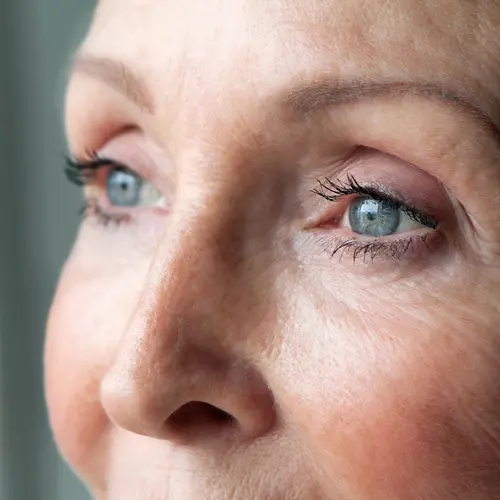Syfovre, also known as pegcetacoplan, is a medicine used to treat geographic atrophy, which is the advanced form of dry age-related macular degeneration. Geographic atrophy can cause irreversible damage to your eyes.
Syfovre is available as an injection given in the eye by a health care provider. It was the first drug approved by the FDA to treat GA.
How Does Syfovre Work for Geographic Atrophy?
In people with geographic atrophy (GA), damaged cells can form in or around a part of the eye called the macula. These groups of damaged cells, called lesions, can damage the macula, leading to loss of your central vision. Once started, this process cannot be reversed. Syfovre slows the growth of these lesions, thereby slowing down the progression of GA. It does this by regulating the overactive part of the immune system involved in creating the lesions.
What Kind of Health Care Provider Prescribes This Medication?
Usually, a retina specialist will prescribe and give Syfovre in an office setting.
How Is Syfovre Given?
Syfovre is an injection given in the affected eye every 25 to 60 days. Your health care provider will decide how often you need treatment.
You may need to remain in the office after it is given to see if you are having any side effects from Syfovre. Your health care provider may perform additional tests to measure the pressure in your eye before and after treatment.
Who Should Not Use Syfovre?
You should not use Syfovre if you have an eye infection or swelling, pain, or redness in or near your eye.
How Was Syfovre Studied?
- Two studies called the OAKS and DERBY studies compared Syfovre injection to a sham injection with no medicine over 24 months in people with GA. People who were in the sham injection group did not receive the actual drug. Instead, the doctor only touched the eye with the syringe but did not inject anything into the eye.
- These studies included over 1,000 people who received either Syfovre or the sham injection either every month or every other month.
- To determine if the drug worked, the size of the lesions was compared before and after treatment for all of the groups.
What Types of People Were in These Studies?
Here are some characteristics of people who participated in these studies.
- The average age was about 78.
- About 60% were female (range: 57% to 62%)
- About 90% were White (range: 91% to 96%), about 6% did not report race (range: 3% to 7%) and less than 1% were Asian, Black, or African American
- The average size of the lesions at the start of the studies ranged from 8.18 to 8.37 square millimeters.
What Benefits Were Seen in These Studies?
- People in both studies had less lesion growth at the end of 1 year and 2 years of Syfovre treatment compared to those who got the sham injections.
- Results for the two studies combined:
- People who received Syfovre monthly for 12 months had 16% slower growth in lesions compared to those who received the sham injections; those who received Syfovre every other month for 12 months had 14% slower growth.
- People who received Syfovre monthly for 24 months had 21% slower growth in lesions compared to those who received the sham injections; those who received Syfovre every other month for 24 months had 17% slower growth.
Your results may differ from what was seen in clinical studies.
What Are the Side Effects of Syfovre, and How Can I Tell If a Side Effect Is Happening?
Contact your health care provider right away if you experience any signs of a serious complication after treatment. This may include symptoms such as redness of the eye, sensitivity to light, pain in the eye, or any change in vision such as blurry vision, wavy or distorted vision, seeing small specks floating in your vision, or seeing flashing lights.
Inflammation of the vessels in a part of the eye called the retina, which may lead to severe vision loss, can also occur. Contact your health care provider right away if you experience eye redness, sensitivity to light, pain in the eye, or any change in vision.
Syfovre has also been associated with eye inflammation, wet age-related macular degeneration (AMD), which is a less common type of late-stage AMD, and increased pressure in the eye. Your health care provider will monitor for signs of these reactions and may measure your intraocular pressure before and after treatment.
The most common side effects seen with Syfovre were eye discomfort, blood in the white part of the eye, wet AMD, and the appearance of small specks floating in the eye. Any changes in vision or redness in the eye, light sensitivity, or eye pain should be reported to your health care provider right away.
These are not all of the possible side effects of Syfovre. Talk with your health care provider if you are having symptoms that bother you. If you experience anything that you think may be caused by Syfovre, you can also report side effects to the FDA at 800-FDA-1088 (800-332-1088).
What Else Do I Need to Know About Syfovre?
Your retina specialist will numb your eye prior to giving you the injection of Syfovre. After the injection, your eyesight may be worse. You should not drive or use heavy machinery until your eyesight returns to normal.
Is There Any Cost Assistance Available?
There may be cost assistance to help you afford Syfovre. You may have options even if you do not have health insurance. The ApellisAssist Program provides insurance support during treatment and helps eligible patients with financial assistance, if eligible. Your health care provider will help you get started. You can contact 888-273-5547 for more information.

